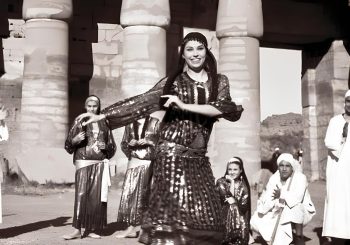Often referred to as the world’s largest open-air museum, Luxor stands as a modern metropolis inhabited by the echoes of a grand past. Towering obelisks, resplendent temples, vibrant culture, and a kind, generous people—words often fall short when describing this rightfully boastful city. Yet, amidst the countless attributes Luxor is celebrated for, wildlife is seldom mentioned.
Egypt’s desert biome is blessed with a richness in biodiversity that offsets its sparse populations. Protected areas like Wadi Al-Gemal, Gabal Elba, and Saint Catherine, as well as remote, pristine regions like Siwa, are well-recognized as hotspots for wildlife. Some of the most breathtaking, beautiful graphic documentation of Egyptian fauna is shot here, but a bustling urban center like Luxor does not share a similar reputation.
To the average visitor, the Upper Egyptian city is a gateway to a lost past. It would surprise many to know that Luxor is also home to a multitude of rare species. In such an environment, wildlife photography could be quite a daunting field. Ken Robinsons shines as one of the few amateur photographers taking on the challenge.
Robinson began taking wildlife photography seriously about two years ago. Throughout his almost two decades of living in Egypt, he has traveled to Fayoum, Siwa, Hurghada, and more.
“I have been living in Egypt for the past 17 years, and during this time, I have taken pictures of everything that is run-of-the-mill—hieroglyphs, monuments, temples. However, I started to think, ‘What else?’” Robinsons tells Egyptian Streets. “I began noticing the animals.”
According to the 64-year-old photographer, most people come to Luxor to visit its temples, tombs, and sights along the Nile. It is rare to find visitors who come for the local birds or mammals, which are already rare in the area. In recent years, however, the retired scaffolder noticed more people walking around and taking wildlife pictures in the ancient city.
“The issue with wildlife photography in a big city such as Luxor is that it is difficult to get close to the animals because of the noise from boats, taxis, cars, and people. That’s why I prefer to go inland before sunrise and explore the farmers’ fields and agricultural land; then, I wait to observe,” says Robinson. “When you know a specific animal’s location, you must get there before they return to their dens. Sometimes, luck plays a role, and you spot them.”
Mammals, in particular, have given Robinson quite a hard time. “While taking pictures of birds is relatively easy, capturing mammals is much harder. Sometimes, you must wait long before spotting a particular bird you’d like to photograph,” he tells Egyptian Streets. “Some of my more challenging subjects include foxes, mongooses, and jackals.”
Red Avadavat

Red avadavats can be found in grassy environments like meadows, gardens, and clearings in the jungle, favoring wetlands and areas close to water, such as sugarcane fields.
Red avadavats have a huge population and a wide geographic range, making them an animal of the least concern according to the International Union for Conservation of Nature (IUCN) Red List.
“They’re pretty little birds but hard to capture on camera. You have to be quick because they won’t stay still for long,” Robinson told Egyptian Streets. “It is a bit of luck, and they’re always in farmland, especially in the sugar cane area.”
The Egyptian Mongoose

The ground-dwelling Egyptian mongoose favors areas with trees close to bodies of water. Particularly at night, they conceal themselves and take refuge in burrows, hollow logs or trees, holes in the ground, and rock crevices. These days, they can even be found in cultivated fields and on the sides of vegetated canals.
The Egyptian mongoose has a large range and population; therefore, it is not in danger of extinction. In most mongoose populations, they are the most numerous carnivores present in the region.
“Mongooses are fun to watch and photograph. Again, you must be very still and hope nobody is around because any little noise will make them run away,” explains Robinson.
“In this picture, I was standing on the walking track between farmlands, and this Mongoose was approaching me. So I just stood still, taking pictures of it coming towards me. It got to about 10 to 12 yards in front of me. And then it stopped. When it looked at me, and we both looked at each other, I took another picture, and it turned around and ran,” he recounts.
The Little Owl

The little owl, often referred to as Athene noctua, resides in a number of different habitats. This species has evolved to thrive in dry environments since rain reduces hunting success. As athene noctua has been spotted at elevations varying from sea level to 2600 meters, habitable environments vary in altitude.
IUCN’s Red List classifies the small owl as least concern. However, little owls have been observed to be declining throughout Europe.
“Little owls sometimes move around during the day, often influenced by the heat. I’m usually lucky. I have an idea of their potential locations while going back. I know where to search, especially for this particular one. This particular owl was perching there, patiently posing for its photo,” Robinson says.
The Egyptian Wolf

Northern Africa is home to African golden wolves which, up until 2015, were thought to be the same species as Eurasian golden jackals. Their natural habitat ranges from Somalia to Senegal in the east and from Algeria to Kenya in the north.
Golden wolves are able to survive in a variety of habitats, including grasslands, mangroves, dry plateaus, and savannas, as a result of their generalist behavior and tolerance of dry environments.
African golden wolves are rated as least concern but declining on the IUCN Red List.
“I have a general sense of their locations and the approximate time I can expect to spot them. I wake up early to reach the location before daybreak. I stand there, patiently and silently, waiting. Most of the time, I capture something around eight out of 10 times.” says Robinson.
“However, occasionally, the animals aren’t very clear or are quite distant—maybe 300 to 500 yards away. Some images turn out a bit blurry. But I’ve been fortunate with certain photos where they’ve been just about 100 yards away. It all boils down to luck, waiting, patience, and quietness.”.
The Indian Silverbill

A frequent resident and breeding bird in the arid parts of the Middle East and the Indian Subcontinent, the Indian silverbill has spread worldwide and established itself in numerous regions. They usually hunt around grassland and scrub in small flocks.
According to the IUCN, the Indian silverbill’s conservation status is of least concern.
“You can often find them in farmlands, perched atop sugar cane or nestled among the reeds along the riverside or canals. They prefer the fluffy tops of the reeds,” Robinson says.
The Egyptian Fox

Red foxes have been observed in various environments, including urban areas, grasslands, deserts, and tundra. Dry, diverse landscapes with patches of scrub, woodland, and agriculture make up their natural habitat.
Red foxes thrive in cities and are more prevalent in low-density suburban residential areas and less prevalent in commercial or industrial hubs.
The IUCN Red List rates red foxes as least concern.
“The one with the fox is in an agricultural field. It was just pure luck that I was in the particular area. It surprised me. It just stood there, and it looked up at me,” Robinson recounts. “You get a good feeling when you get a nice picture like that.”
The Monitor Lizard
The semi-aquatic Nile monitor inhabits a variety of environments. They are usually spotted in wetlands and along riverbanks. Because it relies on water, the water monitor has a widespread distribution.
This species appears hardy despite being heavily hunted for its skin. It has been suggested that the leather trade avoids large females since they produce larger clutches.
“Photographing the monitor lizard is tricky because any slight sound can send them running for cover. I can’t precisely recall where I captured that shot, but it might have been walking near a roadway, possibly on the other side of a tributary. It was lucky I spotted it. Monitors are early risers, often basking in the sun to warm up. Getting that shot was lucky; I managed to capture it before it slipped back into the water to hide,” Robinson recounts.
Wild Bees

A subspecies of the honey bee, the Egyptian honey bee lives in a small area in the Nile Valley region in Egypt and Sudan.
“This picture was taken in an agricultural area. I noticed a lot of activity on a tree and then realized there was a honeycomb covered with bees. I was intrigued and captured some photos; it was quite fascinating,” Robinson says.
Through his work, Robinson captures the intimate moments of intricate connections between urban and wildlife in Luxor. Because of his documentation, Luxor’s lesser-known inhabitants emerge from the shadows, a testament to the beauty and diversity that thrive even in the heart of a bustling metropolis.
Subscribe to the Egyptian Streets’ weekly newsletter! Catch up on the latest news, arts & culture headlines, exclusive features and more stories that matter, delivered straight to your inbox by clicking here.







Comments (2)
[…] post Luxor’s Elusive Wildlife: a Journey Through the Lens of Ken Robinson first appeared on Egyptian […]
[…] Source link […]